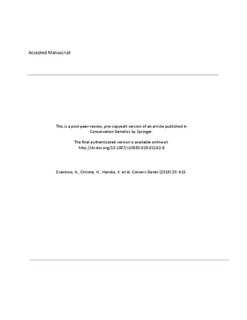| dc.contributor.author | Evankow, Ann | |
| dc.contributor.author | Christie, Hartvig C | |
| dc.contributor.author | Hancke, Kasper | |
| dc.contributor.author | Brysting, Anne Krag | |
| dc.contributor.author | Junge, Claudia | |
| dc.contributor.author | Fredriksen, Stein | |
| dc.contributor.author | Thaulow, Jens | |
| dc.date.accessioned | 2020-01-17T08:17:35Z | |
| dc.date.available | 2020-01-17T08:17:35Z | |
| dc.date.created | 2019-06-06T12:31:02Z | |
| dc.date.issued | 2019 | |
| dc.identifier.citation | Conservation Genetics. 2019, 20 (3), 615-628. | nb_NO |
| dc.identifier.issn | 1566-0621 | |
| dc.identifier.uri | http://hdl.handle.net/11250/2636751 | |
| dc.description.abstract | Knowledge of genetic diversity among wild populations is becoming increasingly important as more species are recognized for their bioeconomic value. Industrialization of natural resources, such as kelp in the marine shallow sublittoral zone through cultivation and wild-harvesting, may lead to extensive translocation and local population decimation. Without adequate resilience in the form of genetic diversity within and across populations and given the potential introduction of deleterious alleles from translocations, such anthropogenically pressured populations may not be able to sufficiently respond to future climate and other stressors. Here we provide an assessment of the genetic heterogeneity of two bioeconomically important kelp species, Laminaria hyperborea and Saccharina latissima, across the Norwegian coastal region from South (57°N) to North (78°N), by applying microsatellite genotyping. Isolation by distance was found for both kelp species when comparing genetic distance to geographic distance. L. hyperborea clustered into four distinct genetic groups corresponding to distinct geographical ecoregions, whereas S. latissima did not show equally strong geographical structuring but separated into three geographical clusters along the Norwegian coast. No genetic differentiation was found within the Norwegian Skagerrak region, corroborating previous findings. The identified genetic clustering of both kelp species supports the retention of established management regions along the Norwegian coast and argues for the continuation of a regional focused management plan for kelp resources. Further, the results demonstrate that care should be taken to prevent translocation of kelp between ecoregions in the ongoing industrialization of kelp cultivation, to maintain a healthy coastal ecosystem and sound natural population genetic diversity. | nb_NO |
| dc.language.iso | eng | nb_NO |
| dc.title | Genetic heterogeneity of two bioeconomically important kelp species along the Norwegian coast | nb_NO |
| dc.type | Journal article | nb_NO |
| dc.type | Peer reviewed | nb_NO |
| dc.description.version | submittedVersion | nb_NO |
| dc.source.pagenumber | 615-628 | nb_NO |
| dc.source.volume | 20 | nb_NO |
| dc.source.journal | Conservation Genetics | nb_NO |
| dc.source.issue | 3 | nb_NO |
| dc.identifier.doi | 10.1007/s10592-019-01162-8 | |
| dc.identifier.cristin | 1703152 | |
| dc.relation.project | Norges forskningsråd: 267536 | nb_NO |
| cristin.unitcode | 7431,13,0,0 | |
| cristin.unitname | Dyphavsarter og bruskfisk | |
| cristin.ispublished | true | |
| cristin.fulltext | postprint | |
| cristin.qualitycode | 1 | |
